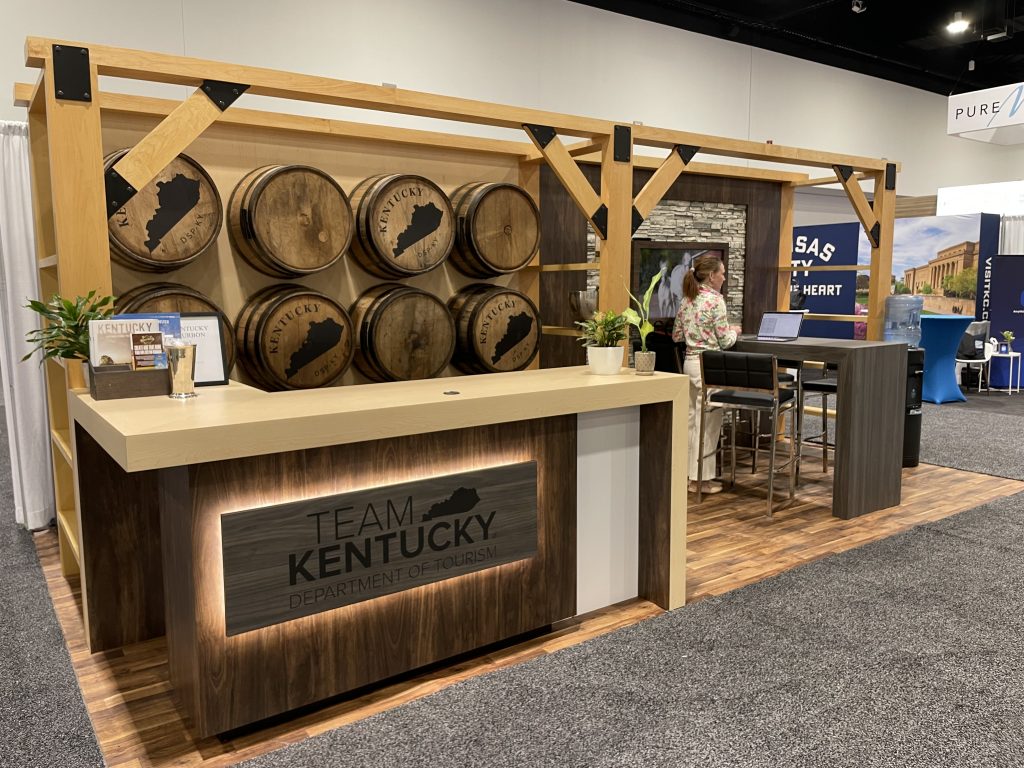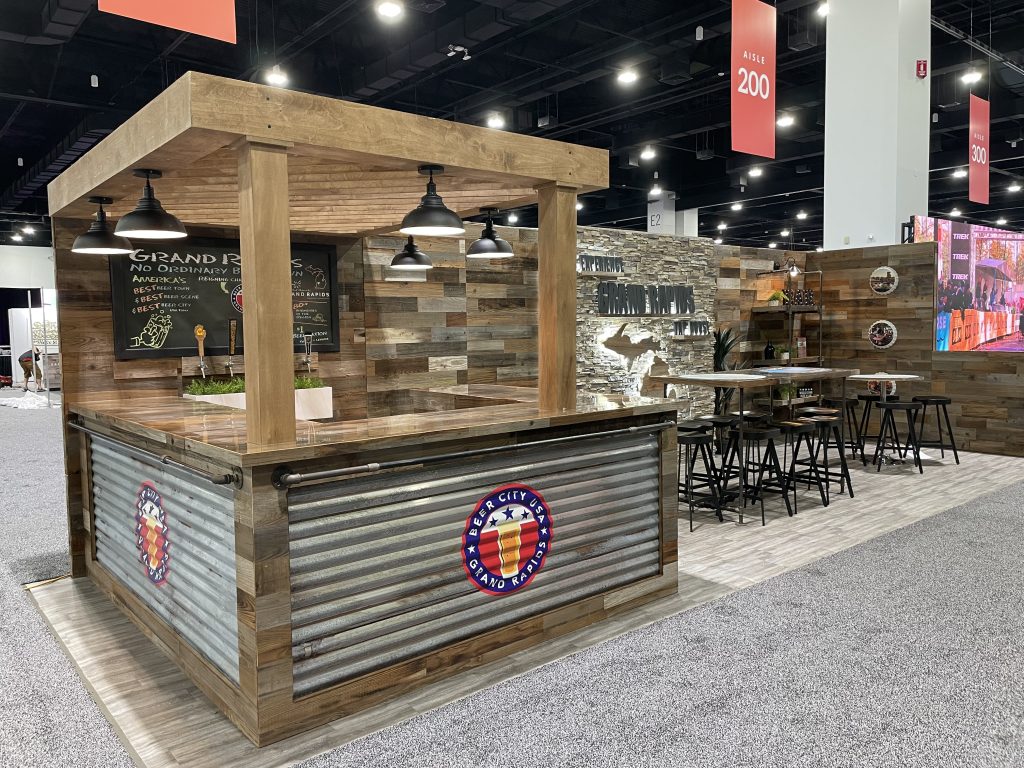
You’re strolling down the main aisle at a trade show when suddenly you smell fresh baked chocolate chip cookies. It’s irresistible, and despite your brain telling you you’re being manipulated, you’re now on a mission to find those cookies. Be prepared, though—the line will be long, but definitely worth it, even if it means listening to a pitch about productivity software.
When it comes to smells, tastes, sounds, and all of our senses, we are driven by memories and primal instincts. Sensory marketing is a powerful tool for all types of events —whether it’s a trade show, supermarket, concert, or sporting event. Smart marketers know this and often combine sight, sound, touch, smell, and taste into a sensory collage tailored to specific audiences. While sensory marketing can sometimes feel like adopting the dark arts, it’s really just based on research, common sense, a targeted strategy, and audience demographics.
What is Sensory Marketing?
Sensory marketing is a strategy that appeals to consumers through their five senses: sight, sound, touch, smell, and taste. By engaging these senses, brands aim to create a more immersive and memorable experience, fostering emotional connections, and driving consumer behavior.
Here’s a breakdown of how each sense can be used in marketing:
- Sight: Visual elements like packaging design, store layout, and advertising visuals can evoke emotions and create a brand identity.
- Sound: Music, sound effects, and voiceovers can influence mood and perception.
- Touch: The texture of products, packaging, and in-store experiences can impact how consumers feel about a brand.
- Smell: Scents can evoke memories and emotions, influencing purchase decisions.
- Taste: Food and beverage products can be a direct sensory experience that influences brand loyalty.
Examples of sensory marketing:
- Starbucks: The aroma of coffee, the sound of espresso machines, and the cozy atmosphere of their stores create a welcoming and inviting experience.
- Apple: The minimalist design of their stores, the sound of their iPhones, and the tactile experience of their iPads contribute to their premium brand image.
- Bath & Body Works: The fragrance and colors in their product, combined with colorful packaging and graphic design, create a relaxing atmosphere.
By effectively utilizing sensory marketing, brands can create a more engaging and memorable customer experience, leading to increased brand loyalty and sales.

The Benefits of of Sensory Marketing
Sensory marketing is a powerful tool that leverages the human senses to create a more immersive and memorable brand experience. By engaging multiple senses, businesses can evoke emotions, enhance brand recall, and ultimately drive customer loyalty. This strategic approach goes beyond traditional marketing tactics, tapping into the subconscious mind and creating a deeper connection with consumers. Sensory marketing can significantly enhance a brand’s connection with consumers. Here are some key benefits:
Brand Recall
- Memory Triggers: Engaging multiple senses creates a more vivid and memorable experience, making it easier for consumers to recall the brand.
- Emotional Connections: Sensory stimuli can evoke strong emotions often linked to long-term memory.
Emotional Connections
- Empathy: Sensory experiences can foster a sense of empathy and connection between the consumer and the brand.
- Positive Associations: A positive sensory experience can create positive associations with the brand.
Customer Satisfaction
- Experiences: A multi-sensory experience can make the customer’s interaction with the brand more enjoyable and satisfying.
- Loyalty: Satisfied customers are more likely to become loyal customers.
Sales
- Attraction: Sensory marketing can attract customers to a product or service.
- Purchase Intent: A positive sensory experience can increase a customer’s intention to purchase.
Differentiation and Brand Identity
- Unique Experience: Sensory marketing can differentiate a brand from competitors by offering a unique and memorable experience.
- Consistency: Sensory marketing can reinforce a brand’s identity by creating a consistent and cohesive experience across all touchpoints.
By leveraging the power of sensory marketing, businesses can create a more engaging, memorable, and effective brand experience.
How to Leverage Sensory Marketing at Events & Trade Shows
Different industries tap into different senses. For example, Natural Products Expo West is a massive event for the natural products industry, featuring food and beverages, dietary supplements, personal care products, and lifestyle products. Expo West’s booth graphics are usually bold and colorful, tasting stations are everywhere, and attendees can expect a barrage of competing scents.
PACK EXPO on the other hand is a trade show that focuses on the packaging and processing industry. The show features the latest developments in packaging machinery, materials, containers, automation, robotics, digital printing, labeling, and supply chain solutions. Smell and taste are mostly non-factors in this show. It’s more about sight, touch, and to a lesser degree sound.
The MAGIC Fashion Events showcase the latest apparel, footwear, and accessories. In addition to the runway events, where designers use runway lighting, music, and elaborate sets to create a visually stunning experience, the exhibitors rely on color, texture, sound, and lighting to evoke an upscale and immersive experience. Smells are important too. Fragrances, like perfumes and colognes, are ubiquitous on models, exhibitors, and attendees, and many venues use scented candles or diffusers to create a specific ambiance.
Sensory Marketing Examples from the Trade Show Floor
Here are 10 examples of how trade show exhibitors can effectively use sensory marketing at a trade show:
1. Tech:
- Visual: Create a futuristic, minimalist booth with holographic displays and LED lighting.
- Auditory: Play ambient electronic music and use sound effects to enhance interactive demos.
2. Luxury Perfume:
- Olfactory: Offer personalized scent consultations and create a luxurious fragrance experience with diffusers and scented candles.
- Visual: Use elegant, minimalist displays with marble and gold accents.
3. Food and Beverage:
- Gustatory: Provide free samples of their products in a variety of flavors.
- Olfactory: Use scent machines to diffuse the aroma of their products throughout the booth.
4. Fashion:
- Tactile: Allow visitors to feel the high-quality materials of their clothing.
- Visual: Use natural, earthy colors and materials in the booth design.
5. Gaming:
- Auditory: Play immersive sound effects and music from their games.
- Visual: Create a gaming-themed environment with LED lights and large screens.
6. Automotive:
- Tactile: Allow visitors to sit in and test drive their vehicles.
- Auditory: Play the sound of their engines and feature interactive displays that showcase vehicle performance.
7. Home Decor:
- Visual: Create a cozy, inviting atmosphere with soft lighting and comfortable seating.
- Olfactory: Diffuse a pleasant scent, such as lavender or vanilla.
8. Fitness Equipment:
- Tactile: Allow visitors to try out their equipment and feel the quality.
- Auditory: Play upbeat music to create a motivating atmosphere.
9. Pet Food or Pet Supply:
- Visual: Display pet products on shelves are pegboards framed with backlit graphics.
- Tactile: Allow attendees to touch and test the pet products and offer sample bags of pet food.
10. Software:
- Visual: Use futuristic, minimalist design elements including interactive videos showing how the software solves a problem
- Tactile: Provide interactive demos that allow visitors to experience the software firsthand.
By engaging multiple senses, exhibitors can create a more memorable and impactful brand experience at trade shows.
Developing an Effective Sensory Marketing Strategy
Developing an effective sensory marketing strategy starts with an understanding of your audience. The audience at SEMA (the Specialty Equipment Market Association), a trade show for automotive specialty equipment, is much different from Cosmoprof North America, a haircare and beauty show in the United States.
- Who is your target audience? What are demographics (age, income, gender)? What are their values (beliefs, lifestyle, interests)? What are their sensory preferences?
- What is your brand identity? What emotions do you want to evoke in your target audience?
- What senses align with your goals? Touch, smell, taste, sight? Something as simple as background music from your audiences’ teens, 20s, and 30s can create the right mood in a trade show booth.
- Finally, create the appropriate sensory experience.
- Sight: Use color, imagery, and design elements that align with your brand.
- Sound: Choose music, sound effects, or voices that communicate the desired emotions.
- Smell: Incorporate scents that complement your brand or products.
- Taste: Offer samples or create a tasting experience, if applicable.
- Touch: Use materials, textures, or packaging that enhance the experience.
At Connect Marketplace, where event agencies, corporate event professionals, convention and visitor bureaus, and suppliers meet, the exhibitors work hard to showcase what makes them unique. For example, in the Grand Rapids, MI booth attendees could sample craft beers from the city’s renowned breweries. At the Visit Albuquerque exhibit, the emphasis was on the region’s unique New Mexico culture and food. Dried chili peppers in the booth gave the booth a pleasant and unmistakable aroma.


Sensory Marketing Conclusion
It’s easy to overlook or ignore sensory marketing as a tool in your trade show toolbox. But that would be a mistake. Too often, exhibitors default to the familiar in their booth, like virtual reality, putting or cornhole games, or an endless video loop. By carefully considering your target audience, brand identity, and the senses involved, you can develop a sensory marketing strategy that creates a lasting impression and drives customer engagement.
For over 30 years, Classic Exhibits has been designing and building creative custom solutions for our Distributor Partners and their clients. As North America’s largest private-label exhibit manufacturer, we have the unmatched capability, capacity, and creativity to create 3D projects ranging from 10 x 10 inline displays to 60 x 80 double-deck islands. Find success on the trade show floor with an exhibit that reflects your marketing message. For more information, see www.classicexhibits.com and explore Exhibit Design Search or request a meeting with a Classic Distributor Partner.



